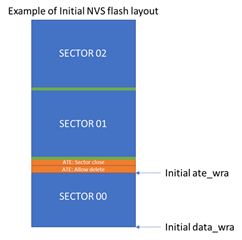Hello,
I am trying to use part of the code from this example https://github.com/zephyrproject-rtos/zephyr/blob/master/samples/subsys/nvs
to write to and read from flash on nRF5340 SoC. However, I am getting the following linking error when building the project in Segger.
I am using Segger v5.34a, NCS v1.5.0-rc1 and Zephyr v2.4.99-ncs1-rc1.
I am including the following header files
#include <zephyr.h>
#include <power/reboot.h>
#include <device.h>
#include <string.h>
#include <drivers/flash.h>
#include <storage/flash_map.h>
#include <fs/nvs.h>
Can you please help ?
1> Linking ‘zephyr_prebuilt.elf’
1> C:\Zypher\v1.5.0-rc1\toolchain\opt/bin/arm-none-eabi-gcc zephyr/CMakeFiles/zephyr_prebuilt.dir/misc/empty_file.c.obj -Wl,-T zephyr/linker.cmd -Wl,-Map=C:/Sandbox/PID4-Firmware/app_core/build_nrf5340pdk_nrf5340_cpuapp_flash/zephyr/zephyr_prebuilt.map -Wl,--whole-archive app/libapp.a zephyr/libzephyr.a zephyr/arch/common/libarch__common.a zephyr/arch/arch/arm/core/aarch32/libarch__arm__core__aarch32.a zephyr/arch/arch/arm/core/aarch32/cortex_m/libarch__arm__core__aarch32__cortex_m.a zephyr/arch/arch/arm/core/aarch32/cortex_m/mpu/libarch__arm__core__aarch32__cortex_m__mpu.a zephyr/arch/arch/arm/core/aarch32/cortex_m/cmse/libarch__arm__core__aarch32__cortex_m__cmse.a zephyr/lib/libc/newlib/liblib__libc__newlib.a zephyr/lib/posix/liblib__posix.a zephyr/soc/arm/common/cortex_m/libsoc__arm__common__cortex_m.a zephyr/boards/boards/arm/nrf5340pdk_nrf5340_cpuapp/libboards__arm__nrf5340dk_nrf5340.a zephyr/drivers/adc/libdrivers__adc.a zephyr/drivers/gpio/libdrivers__gpio.a zephyr/drivers/ipm/libdrivers__ipm.a zephyr/drivers/spi/libdrivers__spi.a modules/nrf/lib/fatal_error/lib..__nrf__lib__fatal_error.a modules/nrf/drivers/hw_cc310/lib..__nrf__drivers__hw_cc310.a modules/hal_nordic/libmodules__hal_nordic.a -Wl,--no-whole-archive zephyr/kernel/libkernel.a zephyr/CMakeFiles/offsets.dir/./arch/arm/core/offsets/offsets.c.obj -Lc:/zypher/v1.5.0-rc1/toolchain/opt/bin/../lib/gcc/arm-none-eabi/9.2.1/thumb/v8-m.main/nofp -LC:/Sandbox/PID4-Firmware/app_core/build_nrf5340pdk_nrf5340_cpuapp_flash/zephyr -lgcc -Wl,--print-memory-usage zephyr/arch/common/libisr_tables.a C:/Zypher/v1.5.0-rc1/nrfxlib/crypto/nrf_cc312_platform/lib/cortex-m33/soft-float/no-interrupts/libnrf_cc312_platform_0.9.7.a -mcpu=cortex-m33 -mthumb -mabi=aapcs -Wl,--gc-sections -Wl,--build-id=none -Wl,--sort-common=descending -Wl,--sort-section=alignment -Wl,-u,_OffsetAbsSyms -Wl,-u,_ConfigAbsSyms -nostdlib -static -no-pie -Wl,-X -Wl,-N -Wl,--orphan-handling=warn -lm -Wl,-lc -LC:/Zypher/v1.5.0-rc1/toolchain/opt/arm-none-eabi/lib/thumb/v8-m.main/nofp -u_printf_float -Wl,-lgcc -lc -specs=nano.specs -o zephyr\zephyr_prebuilt.elf
1> Memory region Used Size Region Size %age Used
1> FLASH: 73512 B 1 MB 7.01%
1> SRAM: 28680 B 448 KB 6.25%
1> c:/zypher/v1.5.0-rc1/toolchain/opt/bin/../lib/gcc/arm-none-eabi/9.2.1/../../../../arm-none-eabi/bin/ld.exe: app/libapp.a(pid4_flash.c.obj): in function `flash_get_page_info_by_offs':
1> C:\Sandbox\PID4-Firmware\app_core\build_nrf5340pdk_nrf5340_cpuapp_flash/zephyr/include/generated/syscalls/flash.h:85: undefined reference to `z_impl_flash_get_page_info_by_offs'
1> c:/zypher/v1.5.0-rc1/toolchain/opt/bin/../lib/gcc/arm-none-eabi/9.2.1/../../../../arm-none-eabi/bin/ld.exe: app/libapp.a(pid4_flash.c.obj): in function `flash_init':
1> C:\Sandbox\PID4-Firmware\app_core\build_nrf5340pdk_nrf5340_cpuapp_flash/../src/flash/pid4_flash.c:45: undefined reference to `nvs_init'
1> collect2.exe: error: ld returned 1 exit status
1> IDT_LIST: 104 B 2 KB 5.08%
Build failed
Kind regards
Mohamed



